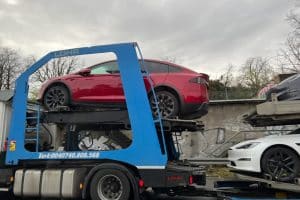- 🚗 Ford plans to release a $30,000 all-electric vehicle within 2.5 years.
- 🧑🔬 The new affordable EV is being developed by Ford’s autonomous “skunkworks” team.
- 🇨🇳 The upcoming EV is expected to compete with Chinese automakers like BYD and Tesla’s next-gen platform.
- ⚡ Smaller electric vehicles are highlighted as crucial for profitability.
- 📉 Large EVs, such as Super Duty models, are not seen as profitable due to expensive batteries.
- 💖 Americans need to “fall back in love” with smaller vehicles for successful EV adoption.
- 📊 Ford’s profitability in EVs is essential in the next five years to compete with global markets.
In a recent interview at the Aspen Ideas Festival, Ford’s CEO Jim Farley revealed fascinating insights about the company’s future direction in the electric vehicle (EV) market. With the announcement of a $30,000 all-electric vehicle, Ford is making bold moves to capture a crucial segment in the automotive market by focusing on affordability and smaller models. Let’s delve deeper into Ford’s strategy and understand why smaller EVs might be the key to profitability and mass adoption.
The Paradigm Shift: Smaller, Affordable EVs
Jim Farley made it clear that Ford’s future lies in smaller, more affordable electric vehicles. The company plans to release a $30,000 EV that promises not only to be budget-friendly but also profitable within the next 2.5 years. This pivot marks a significant shift from the current market trend where larger, luxury EVs dominate.
Why Smaller EVs?
Several factors contribute to this strategic focus:
- Cost Efficiency: Smaller cars generally require fewer materials and smaller batteries, translating to lower production costs.
- Market Demand: There is a rising consumer demand for affordable EVs that can be accessible to the general public, as opposed to high-end, expensive models.
- Environmental Impact: Smaller vehicles often have a smaller carbon footprint, contributing to environmental sustainability, a core principle of the EV movement.
The Role of Ford’s Skunkworks Team
Autonomous Innovation
Ford’s new affordable EV is being developed by an autonomous “skunkworks” team. Operating independently from the main business, this team is tasked with innovating without the constraints of corporate bureaucracy. This initiative ensures that the vehicle development is agile, and groundbreaking ideas can be implemented swiftly.
Competing with Giants: BYD and Tesla
Ford’s upcoming affordable EV is strategically positioned to compete with leading Chinese automaker BYD and Tesla’s next-generation platform.
- BYD: Known for its cost-effective EVs, BYD has been a significant player in the global market, particularly in Asia.
- Tesla: The pioneer of electric mobility, Tesla’s next-gen platform aims to lower the cost of EV production, making it a direct competitor.
By targeting this segment, Ford aims to reclaim its competitive edge in the rapidly evolving EV market.
The Profitability Challenge
Jim Farley underscored that large EVs, particularly models like the Super Duty trucks, struggle to be profitable due to the high cost of batteries, which can be around $50,000. This challenge necessitates a “radical change” in Ford’s approach to EV production.
Steps Towards Profitability
- Capital Allocation: Directing investment towards the production of smaller, affordable EVs.
- Innovation in Battery Technology: Reducing the cost of batteries through research and development.
- Economies of Scale: Mass production of smaller vehicles to lower per-unit production costs.
The American Love Affair with Big Vehicles
Farley made an interesting observation about the American market: consumers are enamored with large vehicles. However, to drive the transition to electric vehicles, Americans need to “fall back in love” with smaller cars. This cultural shift is essential for the long-term sustainability of EV adoption.
Changing Consumer Preferences
Farley’s vision emphasizes:
- Education: Informing consumers about the benefits of smaller EVs in terms of cost, environmental impact, and efficiency.
- Versatility: Showcasing the practicality and innovation of smaller EV designs to cater to diverse consumer needs.
- Legislation and Incentives: Advocating for policies that promote the adoption of smaller EVs through incentives and subsidies.
The Road Ahead: Competing Globally
Ford’s push to make profitable EVs within the next five years is crucial for competing with global markets, especially in regions where Chinese manufacturers like BYD dominate. Failure to achieve this could result in Ford’s market shrinking to North America alone, losing out on the lucrative global stage.
Strategic Imperatives
- Global Supply Chain: Establishing a robust supply chain to support global production and distribution.
- Collaborations and Partnerships: Working with international partners to leverage technology and market reach.
- Continuous Innovation: Staying ahead of technological advancements to maintain a competitive edge.
Conclusion
Ford’s strategic focus on smaller, affordable electric vehicles represents a significant shift in the automotive industry. By innovating with a dedicated team and targeting the $30,000 price point, Ford aims to make electric vehicles accessible and profitable. As the company competes with giants like BYD and Tesla, and encourages Americans to embrace smaller cars, these efforts are poised to reshape the future of electric mobility.
Stay tuned for how these developments unfold and impact the EV landscape.





